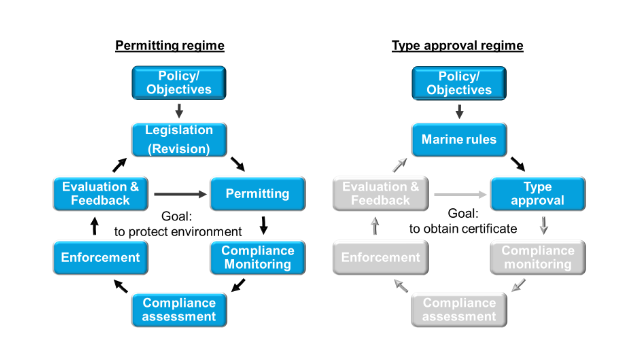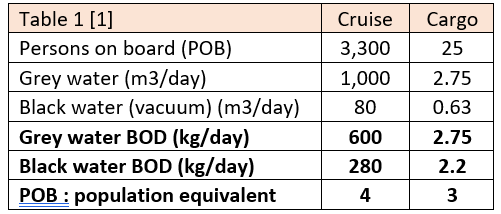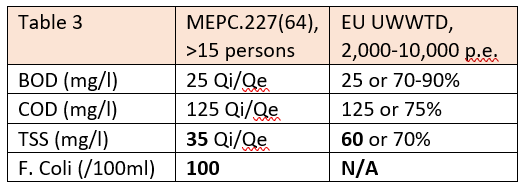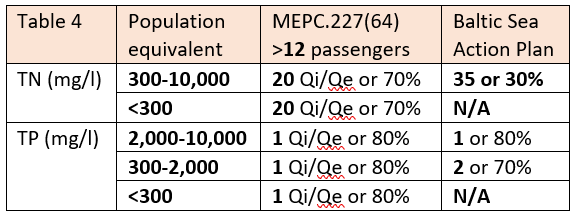Regulating Grey Water - A Necessity

Co-authors:
Dr Wei Chen, Future Program Development Manager, Wartsila Water Systems, UK
Mark Beavis IEng IMarEng FIMarEST, Sales Director, ACO Marine s.r.o., Czech Republic, ACO Marine Systems, Germany
Oliver Jost, Maritime Environmental Affairs, Wasserschutzpolizei (Water Police) Hamburg, Germany
Felix von Bredow, Board of Hamann AG, Hamann AG, Germany
Markus Joswig, Head of Marine Department, PIA GmbH, Germany
Endorsed by:
Benny Carlson, Chairman and owner, Marinfloc, Sweden
Niclas Karlsson, Managing Director, Clean Ship Scandinavia AB, Sweden
Ed White, Environmental Consultant, former Alaska DEC cruise ship compliance manager, USA
Helge Østby, Senior Technical Advisor, Jets Vacuum AS, Norway
Alex Myers, Chief Engineer, Sea Education Association, USA
Antony Chan, MEng CEng MIMarEST, General Manager, Victor Marine Ltd., UK
The IMO’s MARPOL Annex IV is being revised to confirm the lifetime performance of Sewage Treatment Plants (STPs). This may finally bring about grey water regulation – a necessity that is long overdue.
Black water and grey water
A ship’s sewage (black water) is collected from toilets, urinals and hospitals. The IMO’s MARPOL Annex IV prohibits its discharge, except when treated by an STP or discharged at > 12nm from the nearest land. A ship’s grey water, collected from showers, wash basins, laundries, and galleys, is not regulated.
Grey water has more pollutants (measured as BOD or COD) and hence greater environmental impact than black water (Table 1) [1-4]. But logical attempts to regulate grey water have been to no avail [5].

It has been widely acknowledged that the vast majority of approved STPs are discharging ‘virtually untreated sewage’ [6], and the regulation need to be made effective. What may not have been recognised is that, for good technical reasons, an effective black water regulation may not be readily achieved without regulating grey water.
For decades, marine regulators have assumed that a ship’s sewage is similar to sewage on land. It cannot be more wrong. A ship’s sewage is far more concentrated, since urban wastewater contains groundwater infiltration, rainwater, and grey water. Onboard vacuum collection systems push the concentrations even higher, making ship sewage the most concentrated across all industries (Table 2) [1].

Yet, ship sewage is subject to more stringent Faecal Coliform limit when compared to the discharge standards around the world, including the EU land-based rules (Table 3).

It is more so when it comes to the challenging nutrient standards. Under the Baltic Sea Action Plan [7], local communities of up to 300 population equivalent (p.e.) are not required to remove Total Phosphorus (TP). Conventional biological wastewater treatment plant (WWTP) on land can achieve the Total Nitrogen (TN) target of 35 mg/l or 30% without introducing nitrogen removal technologies. As such, local communities of up to 10,000 p.e. are not required to remove Total Nitrogen (TN) (Table 4).

This is not because that the land-based industries are not ambitious, or that local communities don’t care. It is quite the opposite. They have evidence based, practicable, and sustainable environmental regulations that are enforced by performance monitoring (Figure below), whereby the goal is to protect environment, using best available technologies without entailing excess costs or adverse environmental impact. In contrast, passenger ships carrying as few as 12 passengers are given nutrient standards that are considered unnecessary, unbeneficial, and unviable by industries on land (Table 4).

But are these sewage nutrient standards practicable? A ship’s black water can have nutrient concentrations 10 times that of urban wastewater (Table 5). There are other challenges. Ship operators can never be as familiarised with, or dedicated to, an STP as full-time operators in WWTPs. Ships have far less space and far poorer access and have real challenges in logistics and services. Plus, ships pitch and roll....
No one complained. The IMO’s type approval regime has made impossible tasks so ‘easy’ (Figure at top). Ship owners who won’t trust a Bunker Delivery Note have embraced the certification of environmental technologies. Even those ships not applicable for nutrient removal have joined in, oblivious of the implications. It may not be a surprise that the first historical and courageous withdrawal of a certification under the MARPOL Convention was to an STP type approved for nutrient removal [8].
Conditioning vs dilution
The assumption of ship’s black water being similar to urban wastewater is evidently wrong. The assumption of ship’s black water can be readily processed to meet the most stringent standards is not evidence based. It is logical and essential to bring concentrations of black water closer to that of urban wastewater by ‘conditioning’. Afterall, most STPs are tested using urban wastewater that already contains grey water. Large STPs tested on board cruise ships included grey water [9,10]. Under Alaska’s successful permitting regime for cruise ships, grey water is regulated together with black water [11].
Without conditioning, the treated black water, by meeting only the percentage removal target, can still be too concentrated to be allowed into many territorial waters under the national rules. Untreated black water can be too concentrated to be legally received by even the public sewer of the port reception facilities.
Dilution, on the other hand, takes a big step in a wrong direction by using excess amounts of sea water to dilute pollutants, thus cheating the discharge standard.
Regulating grey water is a necessity
Regulating grey water together with black water makes the existing performance standard more attainable and practicable. Because grey water is often co-mingled with black water during storage and transfer on board, regulating grey water is essential for effective implementation of the proposed sewage record books.
There are other reasons too. For years, grey water related non-conformities have been persistent. Sending grey water to an STP’s final stage is a non-conformity wrongly approved and promoted by the classification societies since 2016 [12]. Ship’s grey water system is also becoming a dumping ground for regulated wastes, such as food waste and food waste derivatives, violating international marine rules and national biosecurity rules [13]. The interferences of grey water to the Ballast Water Convention also remain outstanding [14]. Regulating grey water can help to address these issues.
Regulating grey water can ultimately align the maritime industry to the rest of our society in protecting our coastal waters with integrated and consistent regulations, both on land and at sea.
Maritime industry needs evidence-based, practicable and sustainable environmental regulations. At a time when the MARPOL Annex IV is under revision, we can have the grey water issue raised and addressed in one hit, or we can have a piecemeal approach that drags on over decades. Which one is better for the industry, and the marine environment?
References
[1] Sewage discharge to port – what to expect, by Dr E Dorgeloh, and M. Joswig, SOWOS 9, 2015.
[2] https://helcom.fi/wp-content/uploads/2020/01/Technical-guidance-for-the-handling-of-wastewater-in-ports.pdf
[3] https://www3.epa.gov/npdes/pubs/vgp_graywater.pdf
[4] https://oceanconservancy.org/protecting-the-arctic/take-deep-dive/grey-water-passenger-vessels-alaska/
[5] MEPC 72/INF.21, MEPC 72/16/6, DE 54/INF.5
[6] MEPC 71/INF.22, MEPC 74/14, PPR 8/7, PPR 7/16/1, PPR 8/7/4
[7] https://helcom.fi/media/documents/BSAP_Final.pdf
[8] https://www.linkedin.com/posts/wei-chen-05749a14_no-sludge-stps-activity-6770412800591376384-mtUq/
[9] MEPC 60/INF.4 (paragraph 7.3, 7.9, 7.11 and 7.19), 2009
[10] MEPC 67/8, 2014
[11] https://oceanconservancy.org/protecting-the-arctic/take-deep-dive/grey-water-passenger-vessels-alaska/
[12] https://www.linkedin.com/feed/update/urn:li:activity:6761939034337017856/

that matters most
Get the latest maritime news delivered to your inbox daily.
[13] https://shipinsight.com/articles/vanishing-food-waste-flouts-maritime-and-national-law/
[14] MEPC 64/7/2; MEPC 64/7/7, MEPC 64/23, 2012
The products and services herein described in this press release are not endorsed by The Maritime Executive.
